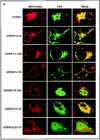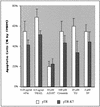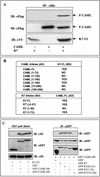Kaposi's sarcoma-associated herpesvirus mitochondrial K7 protein targets a cellular calcium-modulating cyclophilin ligand to modulate intracellular calcium concentration and inhibit apoptosis
- PMID: 12388711
- PMCID: PMC136794
- DOI: 10.1128/jvi.76.22.11491-11504.2002
Kaposi's sarcoma-associated herpesvirus mitochondrial K7 protein targets a cellular calcium-modulating cyclophilin ligand to modulate intracellular calcium concentration and inhibit apoptosis
Abstract
On viral infection, infected cells can become the target of host immune responses or can go through a programmed cell death process, called apoptosis, as a defense mechanism to limit the ability of the virus to replicate. To prevent this, viruses have evolved elaborate mechanisms to subvert the apoptotic process. Here, we report the identification of a novel antiapoptotic K7 protein of Kaposi's sarcoma-associated herpesvirus (KSHV) which expresses during lytic replication. The KSHV K7 gene encodes a small mitochondrial membrane protein, and its expression efficiently inhibits apoptosis induced by a variety of apoptogenic agents. The yeast two-hybrid screen has demonstrated that K7 targets cellular calcium-modulating cyclophilin ligand (CAML), a protein that regulates the intracellular Ca(2+) concentration. Similar to CAML, K7 expression significantly enhances the kinetics and amplitudes of the increase in intracellular Ca(2+) concentration on apoptotic stimulus. Mutational analysis showed that K7 interaction with CAML is required for its function in the inhibition of apoptosis. This indicates that K7 targets cellular CAML to increase the cytosolic Ca(2+) response, which consequently protects cells from mitochondrial damage and apoptosis. This is a novel viral antiapoptosis strategy where the KSHV mitochondrial K7 protein targets a cellular Ca(2+)-modulating protein to confer resistance to apoptosis, which allows completion of the viral lytic replication and, eventually, maintenance of persistent infection in infected host.
Figures








Similar articles
-
Kaposi's sarcoma-associated herpesvirus K7 protein targets a ubiquitin-like/ubiquitin-associated domain-containing protein to promote protein degradation.Mol Cell Biol. 2004 May;24(9):3938-48. doi: 10.1128/MCB.24.9.3938-3948.2004. Mol Cell Biol. 2004. PMID: 15082787 Free PMC article.
-
Identification of the Essential Role of Viral Bcl-2 for Kaposi's Sarcoma-Associated Herpesvirus Lytic Replication.J Virol. 2015 May;89(10):5308-17. doi: 10.1128/JVI.00102-15. Epub 2015 Mar 4. J Virol. 2015. PMID: 25740994 Free PMC article.
-
Novel Role of vBcl2 in the Virion Assembly of Kaposi's Sarcoma-Associated Herpesvirus.J Virol. 2018 Jan 30;92(4):e00914-17. doi: 10.1128/JVI.00914-17. Print 2018 Feb 15. J Virol. 2018. PMID: 29167347 Free PMC article.
-
Pathological Features of Kaposi's Sarcoma-Associated Herpesvirus Infection.Adv Exp Med Biol. 2018;1045:357-376. doi: 10.1007/978-981-10-7230-7_16. Adv Exp Med Biol. 2018. PMID: 29896675 Review.
-
[Replication Machinery of Kaposi's Sarcoma-associated Herpesvirus and Drug Discovery Research].Yakugaku Zasshi. 2019;139(1):69-73. doi: 10.1248/yakushi.18-00164-2. Yakugaku Zasshi. 2019. PMID: 30606932 Review. Japanese.
Cited by
-
Kaposi's sarcoma-associated herpesvirus K7 induces viral G protein-coupled receptor degradation and reduces its tumorigenicity.PLoS Pathog. 2008 Sep 19;4(9):e1000157. doi: 10.1371/journal.ppat.1000157. PLoS Pathog. 2008. PMID: 18802460 Free PMC article.
-
Autocrine and paracrine promotion of cell survival and virus replication by human herpesvirus 8 chemokines.J Virol. 2008 Jul;82(13):6501-13. doi: 10.1128/JVI.02396-07. Epub 2008 Apr 23. J Virol. 2008. PMID: 18434408 Free PMC article.
-
Essential role for CAML in follicular B cell survival and homeostasis.J Immunol. 2012 Apr 1;188(7):3009-18. doi: 10.4049/jimmunol.1101641. Epub 2012 Feb 20. J Immunol. 2012. PMID: 22351938 Free PMC article.
-
Evasion of adaptive and innate immune response mechanisms by γ-herpesviruses.Curr Opin Virol. 2013 Jun;3(3):285-95. doi: 10.1016/j.coviro.2013.05.011. Epub 2013 Jun 2. Curr Opin Virol. 2013. PMID: 23735334 Free PMC article. Review.
-
Recombinant Murine Gamma Herpesvirus 68 Carrying KSHV G Protein-Coupled Receptor Induces Angiogenic Lesions in Mice.PLoS Pathog. 2015 Jun 24;11(6):e1005001. doi: 10.1371/journal.ppat.1005001. eCollection 2015 Jun. PLoS Pathog. 2015. PMID: 26107716 Free PMC article.
References
-
- Alexander, L., L. Denekamp, A. Knapp, M. R. Auerbach, B. Damania, and R. C. Desrosiers. 2000. The primary sequence of rhesus monkey rhadinovirus isolate 26-95: sequence similarities to Kaposi's sarcoma-associated herpesvirus and rhesus monkey rhadinovirus isolate 17577. J. Virol. 74:3388-3398. - PMC - PubMed
-
- Arnaudeau, S., W. L. Kelley, J. V. Walsh, Jr., and N. Demaurex. 2001. Mitochondria recycle Ca2+ to the endoplasmic reticulum and prevent the depletion of neighboring endoplasmic reticulum regions. J. Biol. Chem. 276:29430-29439. - PubMed
-
- Ashkenazi, A., and V. M. Dixit. 1998. Death receptors: signaling and modulation. Science 281:1305-1308. - PubMed
Publication types
MeSH terms
Substances
Grants and funding
LinkOut - more resources
Full Text Sources
Other Literature Sources
Molecular Biology Databases
Research Materials
Miscellaneous

